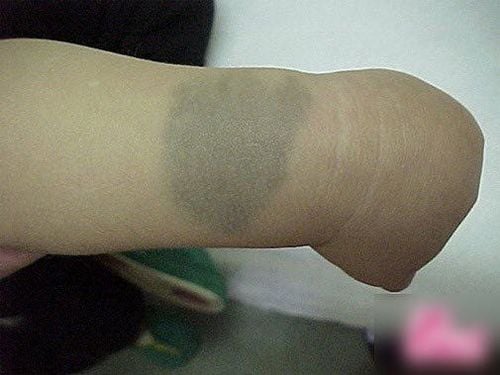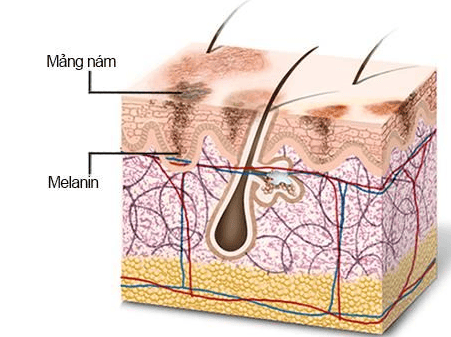This is an automatically translated article.
Congenital skin pigmentation disorder is a condition where there are changes and disorders in the pigment cells on the skin. Although many types of pigmentary disorders are benign, they still greatly affect aesthetics, making children self-conscious and afraid to socialize. Therefore, parents should understand this disease well to have the right treatment for the child.
1. What is congenital skin pigmentation disorder?
Human skin color is mainly determined by two types of melanin, dark brown eumelanin and yellow red pheomelanin. They are present in all skin colors and the ratio will determine the color of the skin. Melanin is produced by pigment cells (melanocytes). Melanin biosynthesis occurs in lysosome-like organelles called melanosomes, which are then transported to keratinocytes. Differences in the number, size, and aggregation of melanosomes in melanocytes and keratinocytes contribute to differences in ethnicity and skin color.
Congenital skin pigmentation disorder is a condition where there are changes and disorders in the pigment cells on the skin. It may be caused by mutations involved in the differentiation and migration of chromatophore precursors in the neural crest or in the proliferation and activity of mature chromatin cells.

Rối loạn sắc tố da bẩm sinh có liên quan đến hai loại melanin, eumelanin
2. Types of congenital skin pigmentation disorders
2.1 Congenital Hyperpigmentation Caused by an abnormality of the pigment cells that appear out of place during the embryonic period. This is a disease that is usually benign but affects the aesthetics, making children have low self-esteem, afraid to communicate with society. Some types of congenital hyperpigmentation include:
Nevus of Ota: A congenital and benign hyperpigmentation of the face. Birthmarks are usually brown, dark brown or greenish-black, no higher than the surface of healthy skin, and are not accompanied by increased hair growth. These birthmarks can appear on one or both sides of the face. This disorder occurs with a rate of 0.2-0.6% and is more common in women than in men. Based on the distribution of chromatin, pigment-eating macrophages and the density of pigment-containing vesicles, the disease can be divided into 5 different degrees of lesions (depending on the depth of distribution in the cysts). structural layer of the skin). Brown spot (Cafe au laite): This is also a congenital hyperpigmentation disorder of the face. Brown birthmarks, uniform or heterogeneous, usually appear on the cheeks and temples. The cause of the disease is still unclear. Treatment methods to date are limited due to the frequent recurrence of the disease. However, there are some patients who can improve the color of the damaged skin with laser treatment. Buttock birthmark: This is a benign birthmark, usually found on the back, buttocks, thighs or torso, rarely on the face. They are flat blue or grayish-green spots with irregular shapes, usually present at birth or shortly after. The spot will usually go away on its own as the child develops. This birthmark is extremely common in Asian children, as well as dark-skinned children, including those of Indian and African descent.

Bớt xanh là biểu hiện của rối loạn sắc tố da bẩm sinh
2.2 Congenital hypopigmentation Hypopigmentation in English is achromic naevus or naevus depigmentosus. This type of birthmark is characterized by areas of pale white skin with well-defined boundaries, ranging in size from a few centimeters to larger. The hypopigmented birthmarks have irregular margins, even slightly zigzag, but clearly demarcate the normal skin. Birthmarks are usually present at birth and become more prominent and stable over time. The most common site of hypopigmentation is on the trunk, but can also be found in other parts of the body.
The pathogenesis of hypopigmentation is related to a mosaic mutation in the skin, which causes a change in the melanocyte lineage, thereby reducing melanin production, reducing the number of melanocytes or disrupting the movement of cells. transport pigment vesicles to keratinocytes. Congenital hypopigmentation is divided into several different types based on the pattern of distribution, including:
Isolated hypopigmentation Segmental hypopigmentation Banded hypopigmentation
3. How to treat skin with pigmentation disorders?
Types of skin pigmentation disorders can be benign or malignant. When malignancy is suspected, the doctor may conduct a biopsy to diagnose and provide timely treatment. In the case of benign skin pigmentation disorders, many patients want to quickly remove the damaged skin for cosmetic reasons. Currently, there are many methods to treat congenital skin pigmentation disorders. Experts note that some treatments can lead to scarring. Treatments for skin pigmentation disorders include lasers, surgery to remove lesions, chemical peels, bleaching agents containing hydroquinone, etc.
In short, congenital skin pigmentation disorders can be It is benign and disappears on its own with time. However, many cases of birthmarks are large, appear on the face and take a long time to disappear. They are the cause of loss of aesthetics, making children shy and self-deprecating. At that time, parents should take their father to medical facilities for examination and appropriate treatment.
Please dial HOTLINE for more information or register for an appointment HERE. Download MyVinmec app to make appointments faster and to manage your bookings easily.













